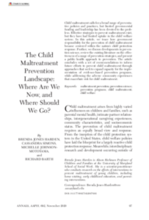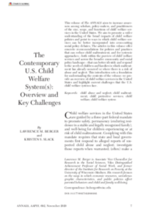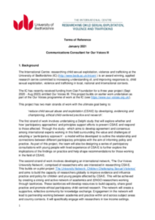Demographic Data
|
Sources: World Bank, UNDP, UNAIDS, DHS 2013 |
Displaying 2831 - 2840 of 14390
The present research study is an exploratory study to examine factors like lack of communication and attachment to parents, abuse, poverty and peer influence with a sample size of 100 runaway children (50 girls, 50 boys) residing in a non-governmental organisation in NCR, Delhi.
In this article, the authors trace how government responsibility for the prevention of child maltreatment became centered within the U.S. child protection response.
This article examines existing knowledge on the scope, nature, and causes of child abuse and neglect in the U.S.
This article summarizes the causes of racial disproportionality, arguing that internal and external causes of disproportional involvement originate from a common underlying factor: structural and institutional racism that is both within child welfare systems and part of society at large.
This introduction sets a foundation for understanding the contents of this volume of The ANNALS, which aims to increase awareness among scholars, policy-makers, and practitioners of the size, scope, and functions of child welfare services in the United States.
This article provides an overview of the funding streams that finance the U.S. child welfare system, reviews the federal legislation since 1970 that has led to the current funding structure, and ends with a discussion of how the Family First Prevention Services Act of 2018 has the potential to create better outcomes for children and families by promoting prevention activities and program support with strong evidence of success.
This article considers how U.S. child welfare agencies can best leverage the opportunities presented by the Family First Prevention Services Act of 2018 while addressing potential barriers posed by the paucity of evidence-supported prevention programs and avoiding the unintended consequences of limiting reimbursement to only selective prevention services that meet rigorous evidence standards of effectiveness.
The author of this article analyzes young people’s experiences in foster care from a life course perspective, accounting for when foster care happens, how long it lasts, and what happens when foster care placements end.
The International Centre: researching child sexual exploitation, violence and trafficking (IC) at the University of Bedfordshire in the UK are seeking to appoint an influencing and communications consultant - who has an awareness of international children’s rights policy and practice - to undertake a mapping of key stakeholders and develop a communication and influencing strategy and action plan for a project addressing child sexual abuse and exploitation.
This second webinar in the 'Introducing Guidance for Alternative Care Provision During COVID-19' webinar series hosted on 28 January 2021, is aimed at policy makers and explains their role in developing policies and guidance to prevent family separation during an outbreak.





